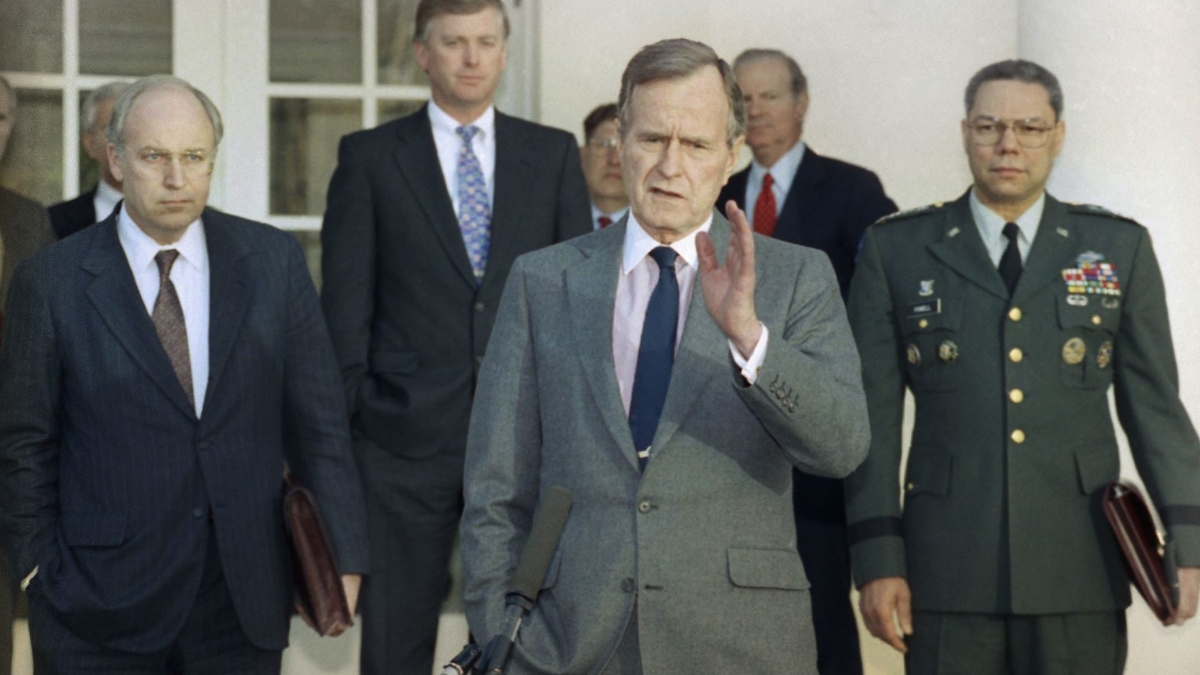20. PEACE


POST-COLD-WAR AMERICA
 The Gulf War or "Desert Storm"
The Gulf War or "Desert Storm"(1990-1991)
 Realism replaces Boomer Idealism
Realism replaces Boomer Idealism
 The Defense of Marriage Act (DOMA -
The Defense of Marriage Act (DOMA -
1996)
The textual material on page below is drawn directly from my work
A Moral History of Western Society © 2024, Volume Two, pages 366-371.
THE GULF WAR OR "DESERT STORM" (1990-1991) |
| With
Egypt knocked out as the leading spokesman for the Arab world, Iraq
finally had the opportunity to take over that privileged position. Thus
Iraq's Ba'athist military dictator (since 1979) Saddam Hussein had been
pushing hard to establish himself as that Arab voice. But there were a
number of problems facing him in that enterprise. The biggest problem was that Iraq itself was not truly a nation – but instead a collection of various ethnic and religious groups … which had little love for each other. Indeed, the only reason for the existence of Iraq was that the British themselves drew up the design for the country when they carved up the Ottoman Empire at the end of World War Two … adding the oil-rich Kurdish (non-Arab) community in the North to the divided Arab world (mutually hostile Sunnis and Shi'ites) to the South – all for the sole purpose of giving British Petroleum control over this vast oil-rich region. The British even set up a "British-protected" Hashemite monarchy for Iraq – which did not much outlast the withdrawal of British influence in the region after World War Two. In fact in 1958, Sunni Ba'athist officers in the Iraqi army overthrew the monarchy in a very bloody coup that year … and with General Abd al-Karim Qasim in control, began the political contest with Nasser for leadership of the larger Arab world. Qasim of course had his own goals – and problems – at home to deal with. The Kurds in the north were fighting among themselves … upsetting the Iraqi political scene greatly. And it infuriated Qasim that the British had set oil-soaked Kuwait apart from Mesopotamia (ultimately "Iraq") in the British carve-up of Ottoman Turkey – because tiny Kuwait was more likely to remain under full British control. Qasim felt strongly that Kuwait belonged to Iraq. But Qasim was himself overthrown (with British and American help) in 1963 … because he had brought the Cold War to Iraq by siding closely with the Soviets. But the pro-Western regime that then came in place did not last long before it too (1968) was overthrown by another Ba'athist coup, the one that eventually brought Saddam to power. But Saddam would find himself absorbed over the next eight years in a futile war with Iran – one that he had undertaken thinking he might lure the Arab minority living just inside Iran next to the Iraqi border to join his Iraq … and bring their own oil lands into his country. But that part of the Arab world (including most of the huge Southeastern portion of Iraq) was Shi'ite – whereas the Ba'athist were Sunni in religious affiliation. And thus the Shi'ite Arabs in Iran seemed to prefer to stay with Shi'ite Iran than join Saddam's Sunni-controlled Iraq … or at least that is how Iran played the matter. In any case, the long war led to nothing for Saddam … except deep national debt. At this point he looked to the matter of long interest to Iraq: Kuwait. Grabbing Kuwait would add enormously to Iraq oil income (the latter not always reliable because of the turmoil that often broke out in the oil lands of the Kurdish North). But grabbing Kuwait would likely bring some kind of a reaction from the oil-dependent Western world. So … Saddam (who had been heavily dependent on American support during his long war with Iran) inquired of the American ambassador at to what she thought would be the American reaction to such a move – and was given the answer that America had no interest in the boundary question with Kuwait … and wanted to stay out of a dispute over Iraq's claim that somewhat now pro-Soviet Kuwait was slant drilling in an attempt to reach Iraqi oil reserves. Saddam thus took this as a "go-ahead" response on America's part. Consequently, in August of 1990, Saddam sent Iraqi troops into largely defenseless Kuwait in order to take over the country. This was supposed to make him a great Iraqi hero ... and a tough Arab leader. But American President Bush had a very different view on the matter than his Iraqi ambassador … and answered the cry of some of the rest of the Arab world in opposition to this takeover. Saudi Arabia was particularly upset, fearing that Saddam's grab of defenseless Kuwait could prove to be merely the first step towards a takeover of an equally defenseless Saudi Arabia (which had never seen the need to possess a strong military). Thus Bush told Saddam to get out of Kuwait. But at this point, this seemed to be an impossible request … as his political reputation would be ruined by such a backdown. So the matter dragged on as both sides, Iraq and a growing American-led coalition, tried to find a diplomatic solution to the problem. Finding none, finally in mid-January (1991) a massive aerial bombardment of the Iraqi forces occupying Kuwait got underway … to which Saddam responded with his own scud missile attack on the 35-nation coalition assembled in Saudi Arabia (but also on Israel). A month later (mid-February) the coalition was ready to move on Saddam's forces in Kuwait … and in very short order threw those very troops out of the country ... with Iraqi troops setting fire to all the Kuwaiti oil wells in their retreat.1 Then this same force followed his troops into Iraq … but halted once it had become clear that Saddam had lost all further ability to conduct military operations. But much criticism was aimed at Bush during all this … at first by the Liberals in Congress for undertaking such an "imperialist" operation in the first place (protests which died away quickly when it became apparent how effective Bush's actions had been) … and then by war hawks who were upset that Bush did not finish the job and just get rid of Saddam. Only later, when Bush's Secretary of Defense Dick Cheney (at that point out of Washington and serving as Halliburton's CEO) was being interviewed, he explained that Bush was well aware that to get involved in trying to reassemble a broken post-Saddam Iraq would come at a huge cost – with no obvious benefits to America. In fact, to do so would be the equivalent of falling into a "quagmire." Wise words … soon forgotten by Cheney himself! 1But these were put out fairly quickly by Texan Red Adair's firefighters … though not before a billion barrels of oil had been lost. 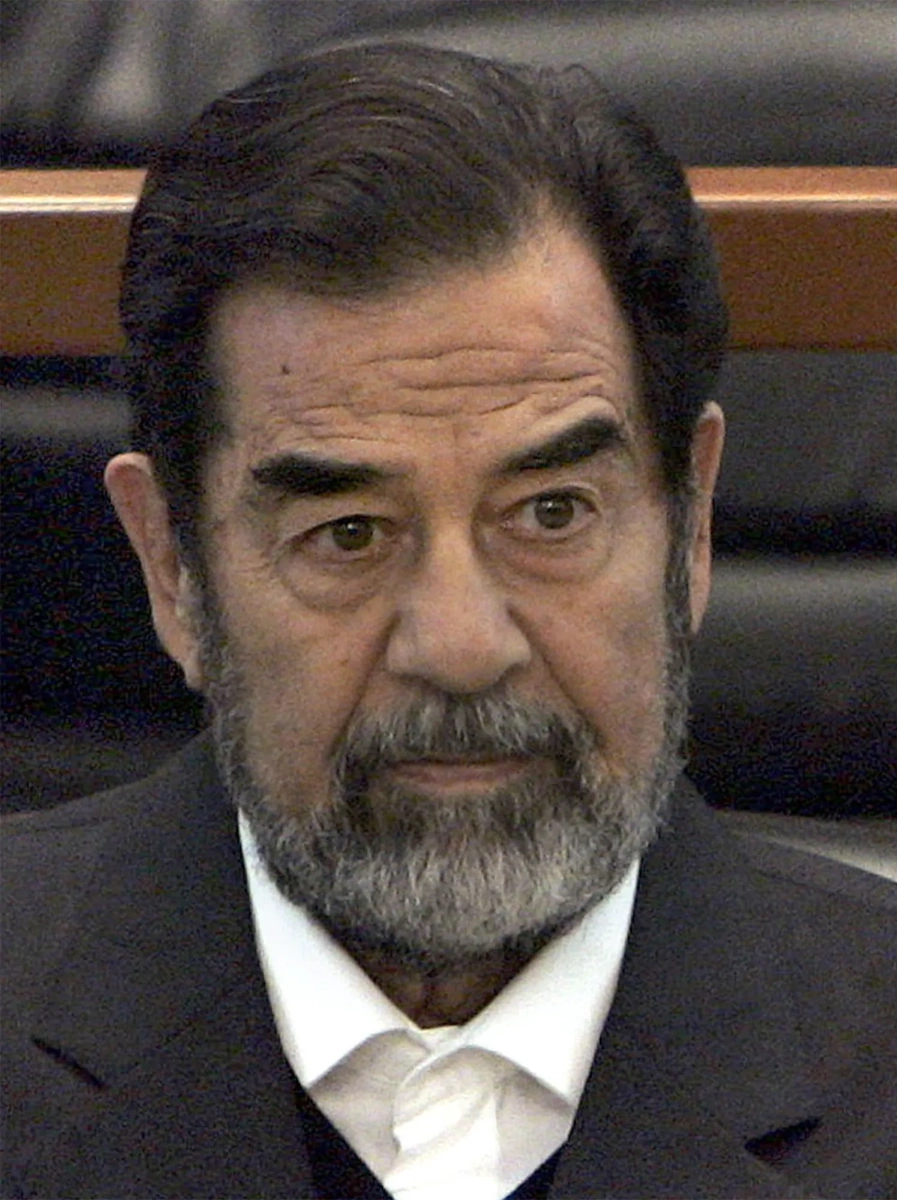 Iraqi dictator Saddam Hussein
(at one point an ally ... in his war with Khomeini's Iran. Now an adversary

President George Bush enjoys
Thanksgiving Dinner with U. S. troops stationed in the
President Bush addressing the press - February 11, 1991 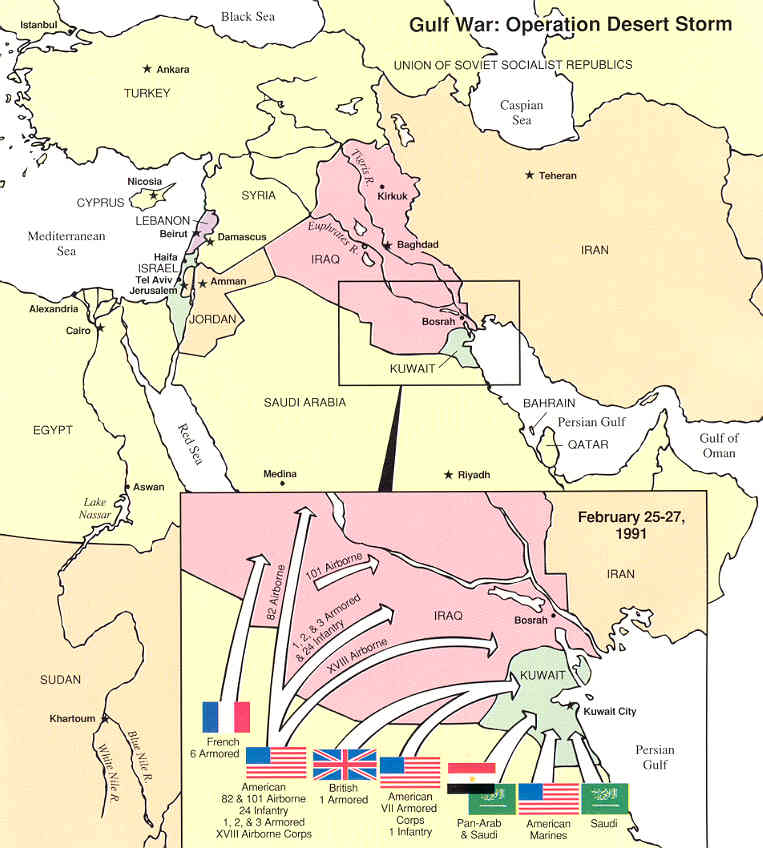
Keesee and Sidwell, p. 633 Gulf War - Air raid over
Baghdad January, 1991. Refueling an F-117 bomber
over Iraq. 
Infrared image of a Iraqi telecommunications building about to be blown up by a Stealth-fired intelligent rocket.. 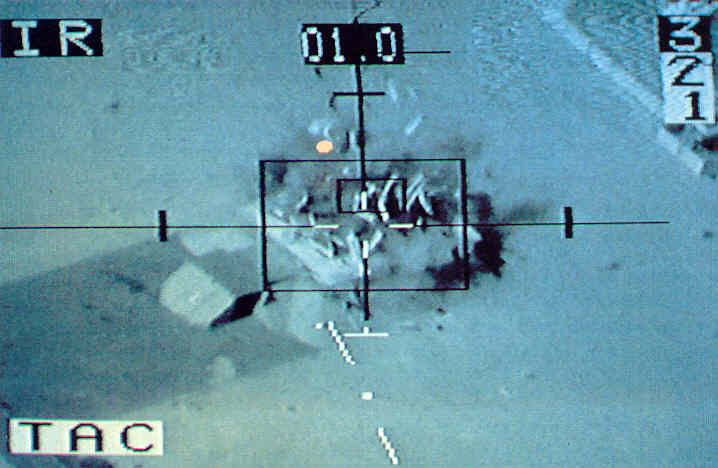
Sighted missile targeting
Iraq - 1991 
A US bomber attack of the
Iraqi positions. US tank assault on Iraqi
lines - February 1991. 
Iraqi troops
surrendering. US Marines taking Iraqi
prisoners. 
A Saudi soldier inspects
a burned-out Iraqi armored vehicle and dead Iraqi solder. America's allied Arab troops
celebrating victory. February 1991 - Gulf War
or "Desert Storm." Burning oil well silhouetted by a destroyed Iraqi
tank. Wreckage and burning oil
fields in Kuwait in the wake of a rapidly retreating Iraqi army. US soldiers and Kuwaiti oil
fields set ablaze by retreating Iraqis - 1991 The Gulf War in Kuwait -
March 2, 1991 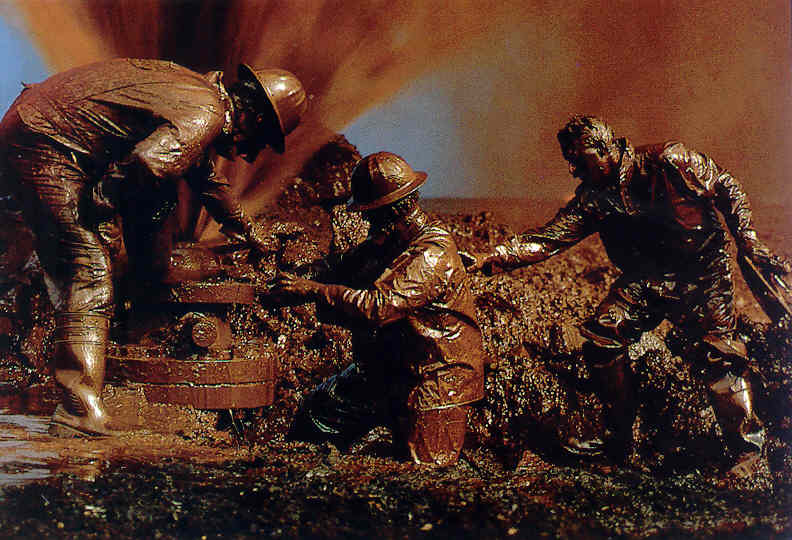
Red Adair's team putting out the Kuwaiti oil well fires started by the retreating Iraqis - 1991 Saddam Hussein is put under international restriction because of the cruel way (employing chemical and biological weapons) he put down the rebellions (encouraged – but not actively supported – by the US) of the Shi'ite and Kurdish communities in Iraq which have long resented tremendously the domination of Iraq by the Sunni community and its political arm, Saddam Hussein's Ba'athist Party 
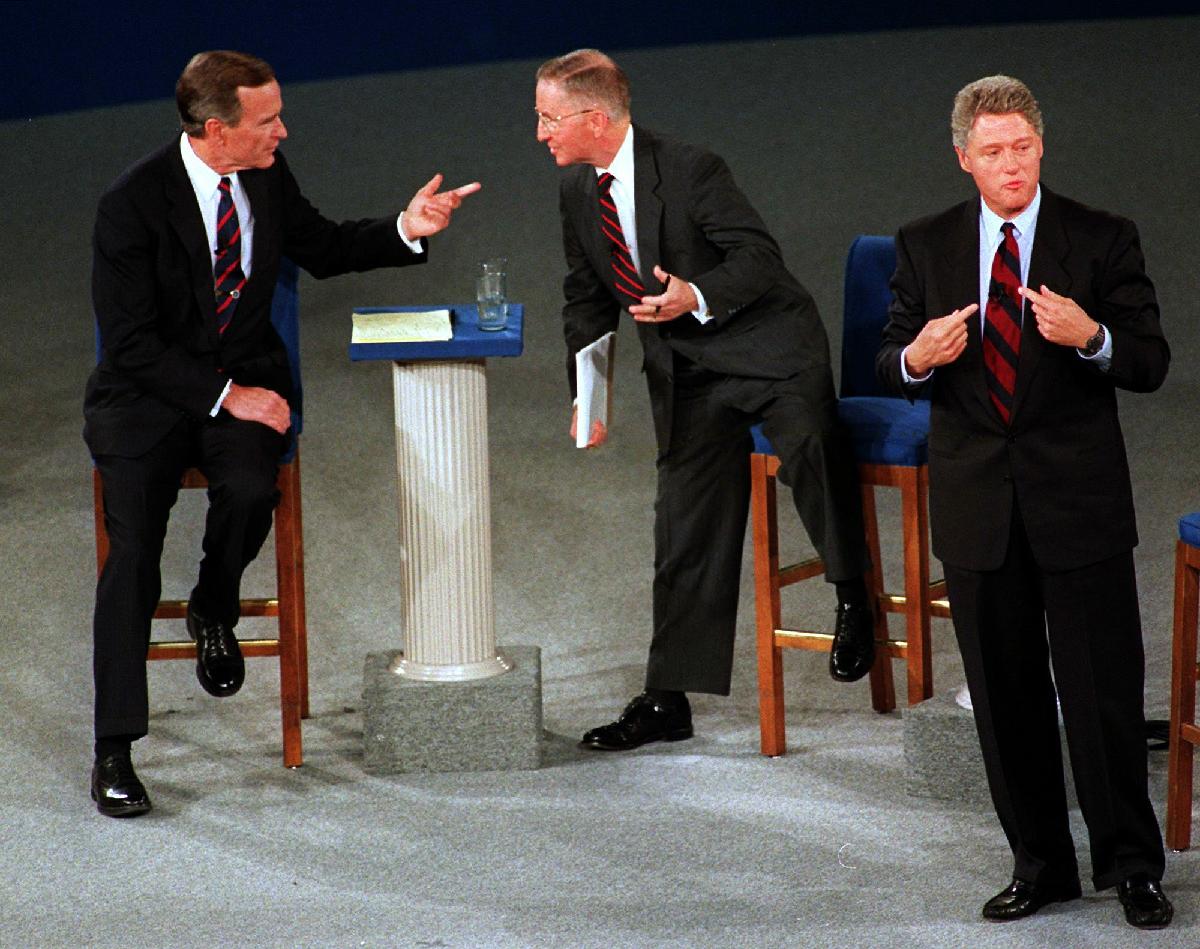 Bush, Ross Perot and Bill Clinton during the 1992 Presidential debates 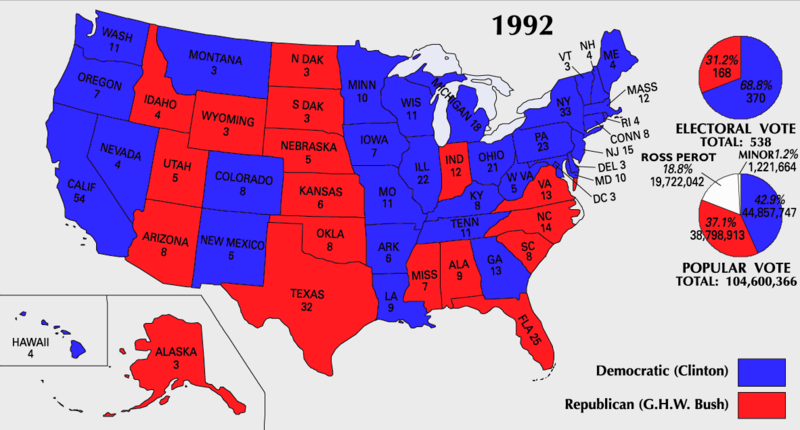

William Jefferson Clinton – President: January 20, 1993 – January 20, 2001
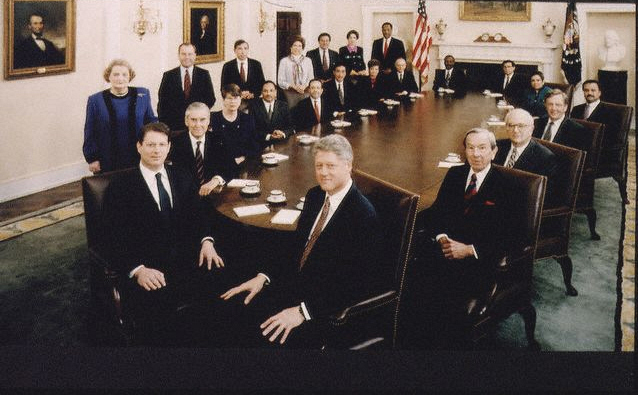

Gingrich explaining his "Contract with
America" to the public - 1994
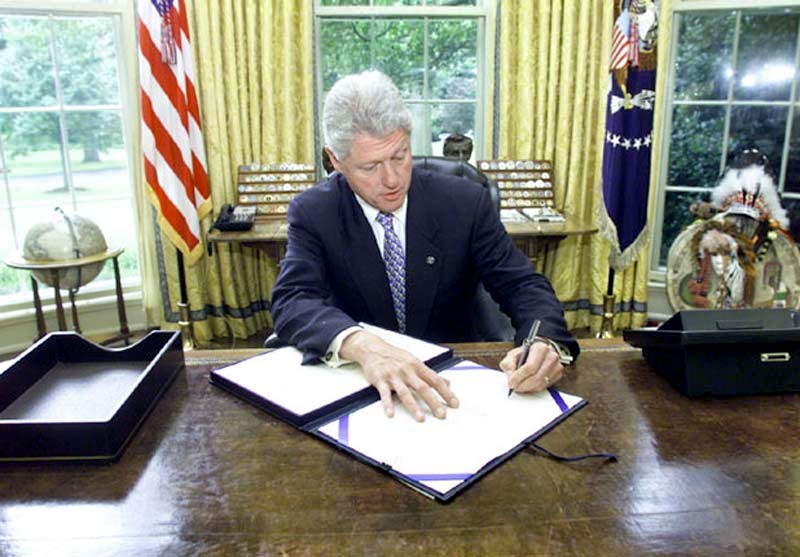 September 21, 1996 – President Clinton signing the Defense of Marriage Act (DOMA)  Go on to the next section: America Takes the Lead
 |

